
ClickBank Traffic Trends Special Report:
Which Marketing Channels Are Thriving in a Rapidly-Changing E-Commerce World?
Key Takeaways
- E-commerce’s total share of retail sales grew more than 4.5% in just one year due to the COVID-19 pandemic, and it continues to eat into traditional brick-and-mortar sales every year.
- With growth in e-commerce comes growth in competition. Paid social ads in particular are getting more expensive – for instance, Facebook CPMs increased nearly 50% in one year.
- ClickBank surveyed hundreds of our own 7-figure business clients to find out which marketing channels they’re focused on, where their biggest investment will be, and much more.
- We’ve identified the top 3 channels for businesses in 2022: email, Facebook Ads, and affiliate marketing. See what the experts are saying about each channel, including essential action items your business must take this year.
- For 2022, the bottom line is channel diversification. With so many digital avenues for reaching your customers, plus increased e-commerce competition across the board, it’s important to know the trends and start positioning your business to take advantage of them now!
Introduction: What Happened in 2021?
If 2020 was the “year of the pivot,” then 2021 was the year where clear, sustainable trends emerged in the world of e-commerce. Many would argue that the recent COVID pandemic has dramatically accelerated the pre-existing shift toward buying and selling online – and in this report, we have the numbers to prove it.
Obviously, more and more shoppers and business owners have been making the jump to online shopping and selling, but what story do the numbers tell? And perhaps more importantly, how can you use this data to make good decisions for your business in the coming months?
We’ll start with the biggest trends in e-commerce, followed by exclusive data from ClickBank on how businesses are responding and which channels they’re relying on in 2022.
The Latest Ecommerce Trends
First, let’s look at e-commerce as a whole.
We define e-commerce as the purchase and sale of all goods and services on the internet. In 2021, e-commerce sales reached nearly $5T worldwide – and they are projected to reach $6.4T by 2024, a percentage increase of 28%!
Aside from the growth in total e-commerce sales, the best way to truly understand the growth of e-commerce is to see it in the context of traditional retail sales.
This chart from Statista shows the e-commerce share of total global retail sales.
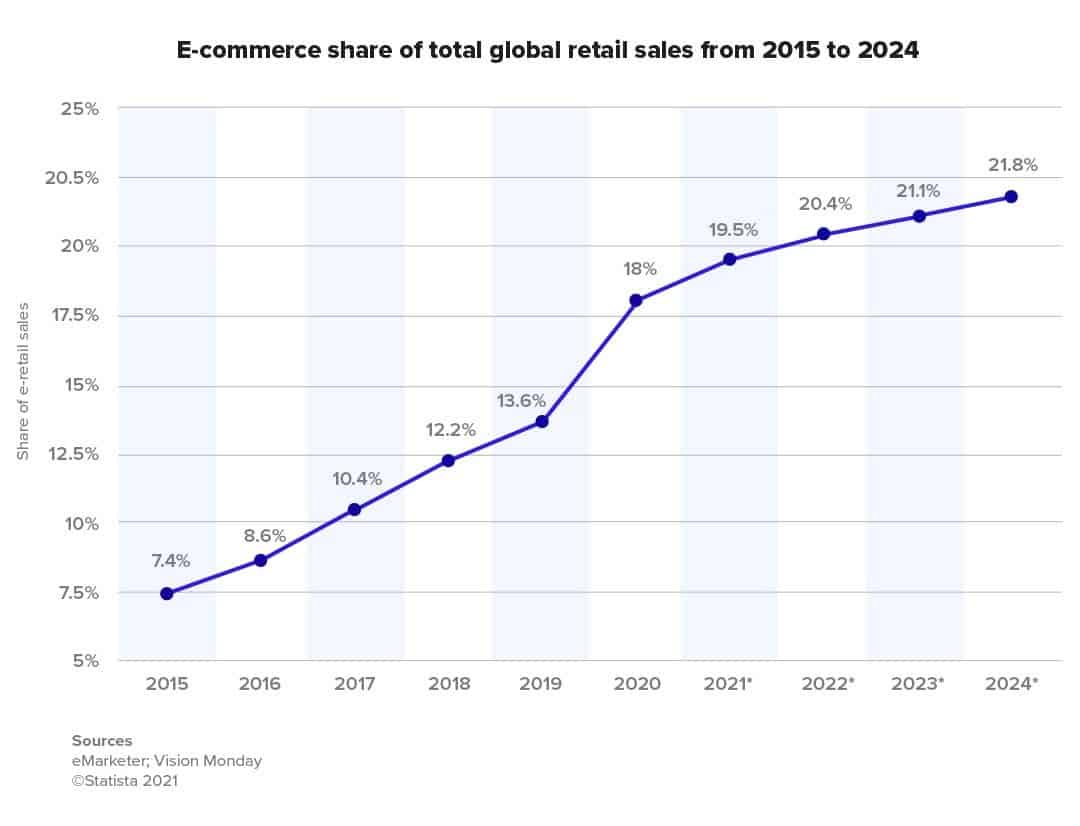
This trend line highlights the increasing proportion of retail sales that are happening online compared to all retail sales. (Did you notice the sharp rise from 2019 to 2020?)
While e-commerce has been gradually taking up a greater share of total retail sales globally for the past five years, the pace of change has held steady at a moderate 1.2% to 1.8% growth rate per year.
When the pandemic hit, however, the global share of e-commerce in retail sales jumped nearly 4.5% from 2019 to 2020 – that’s just in one year!
Even as the trend settles back to its usual pace of roughly 1% growth per year, e-commerce is projected to account for nearly 1 in 4 retail sales by 2024. We’re seeing more businesses take their storefronts online, as well as an increased blending between offline and online retail experiences and cross-channel services.
Social Commerce Trends
Within the broader e-commerce growth trends, one segment is seeing particularly strong traction: social commerce (or s-commerce).
Social commerce represents the intersection between social media and e-commerce. It refers to online retail sales that occur directly on social networks like Facebook, Instagram, and WeChat – and more broadly, to economic activity and promotion facilitated by social networks.
S-commerce sales totaled $36.6B USD in 2021, but will reportedly more than double to $79.6B USD by 2025.
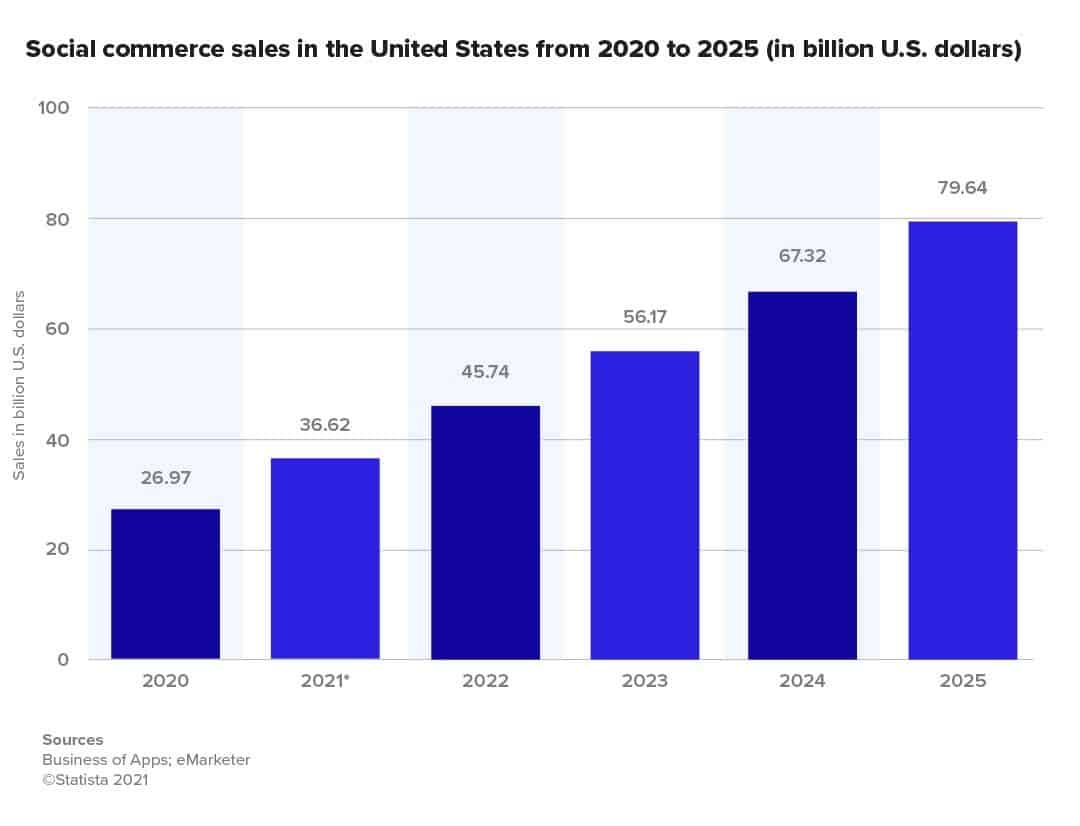
Similarly, the share of online retail sales for social commerce is projected to grow from 4% this year to 5.2% by 2025.
The prevalence of S-commerce is most apparent in China, as 46.4% of all Chinese internet users bought from a social network in 2021 (compared to 35.9% of US internet users).
In the United States, buyers are getting more comfortable making purchases on social media sites, but typically use social media to learn about products and then click through on ads or organic post links to buy on a third-party website or e-commerce store.
Another key trend with social commerce is the rise in social media advertising costs. According to Statista, the cost per 1000 impressions (CPM) on social media advertising grew from an average of $4.51 USD in Q2 2020 to $6.37 USD in Q2 2021 – a nearly 50% increase in just one year.
Mobile Commerce Trends
The third e-commerce trend we want to showcase is the growth in mobile commerce (m-commerce).
Mobile commerce refers to online transactions that take place on mobile devices, primarily smartphones. In 2021, mobile commerce spending in the US totaled a massive $47.8B USD. Tellingly, the growth rate of m-commerce in 2021 was 12.2%, compared to 9.7% for e-commerce in general (ie desktop) and just 4.8% for in-store sales growth.
In terms of the trend here, it’s no surprise that mobile commerce is picking up steam worldwide – in fact, 70% of traffic to e-commerce pages is now coming from mobile devices. What’s interesting is the why.
Statistics show that emerging markets like Southeast Asia are rapidly adopting mobile devices and gaining access to the internet for the first time. Many of these first-time buyers are getting on the internet via mobile and bypassing desktop altogether, a phenomenon that is likely to accelerate in the coming years.
As important as the increase in mobile commerce activity is, it’s important to put it in perspective. The conversion rate by device type below shows that in the United States, desktop traffic converts roughly 0.4% better than mobile.
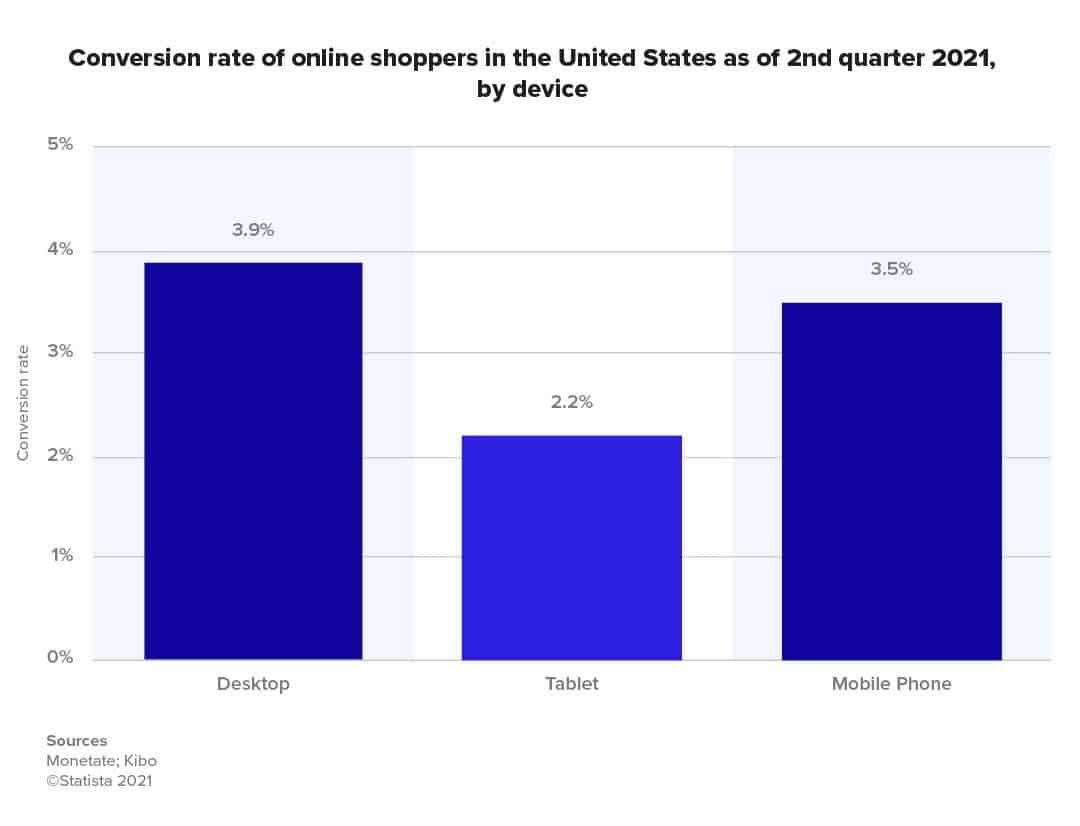
But if you expand this to online shoppers globally, the conversion rate for desktop is 2.59% compared to 1.86% on mobile.
So, as important as mobile is, it appears that more sales still occur on desktop for most online businesses. How long this trend holds is another question.
A Sharp Increase in Business Competition Online
The pandemic has radically accelerated a trend that had been advancing for years: the shift toward online shopping. As reported in the New York Times, from April to June 2020, as the first wave of the virus spread, Amazon sold 57 percent more items than it had a year earlier.
It’s important to note that this change in behavior is occurring among consumers and businesses alike. According to a Morning Consult survey in March 2020, more than 10% of respondents between 18 and 54 had made their first online purchase ever within the prior few weeks, due to the pandemic.
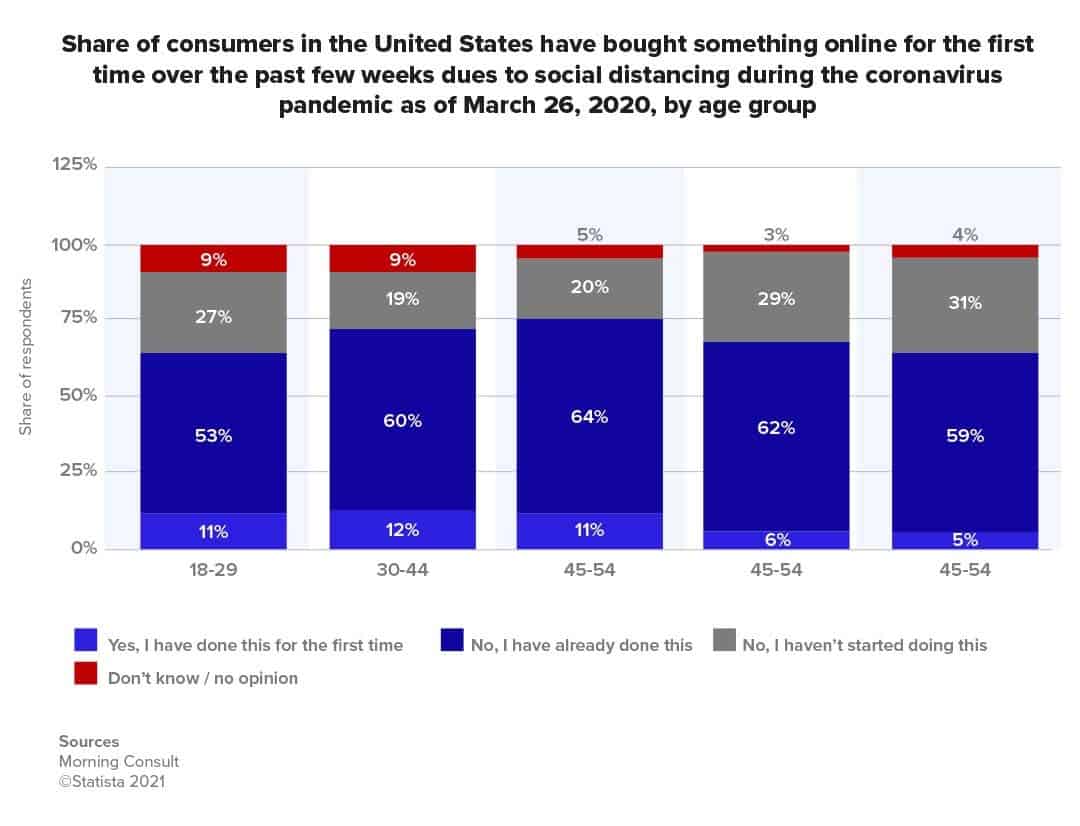
As for businesses? The surprising fact is, during lockdown in 2020, Americans filed to start a record 4.3 million businesses, according to data from the Census Bureau, which was a 24 percent increase from the year before.
This is the highest volume of applications in one year that the government has recorded since it started tracking the number more than 15 years ago – and the volume of applications is likely to be even higher for 2021!
A huge part of this business boom is the uniquely modern ability to go digital. E-commerce has leveled the playing field, allowing Mom and Pop to have worldwide reach and distribution with minimal need for start-up capital. Clearly, online businesses are easier to start than ever before, thanks to innovative opportunities like print on demand, dropshipping, and affiliate marketing.
On the one hand, it’s encouraging to see such a strong revitalization of entrepreneurship in the United States – but on the other hand, this wave of brand-new businesses is contributing to greater competition for anyone selling products and services online.
You can see this borne out in the amount of money being spent worldwide on online video advertising, one of the most prominent paid marketing segments.
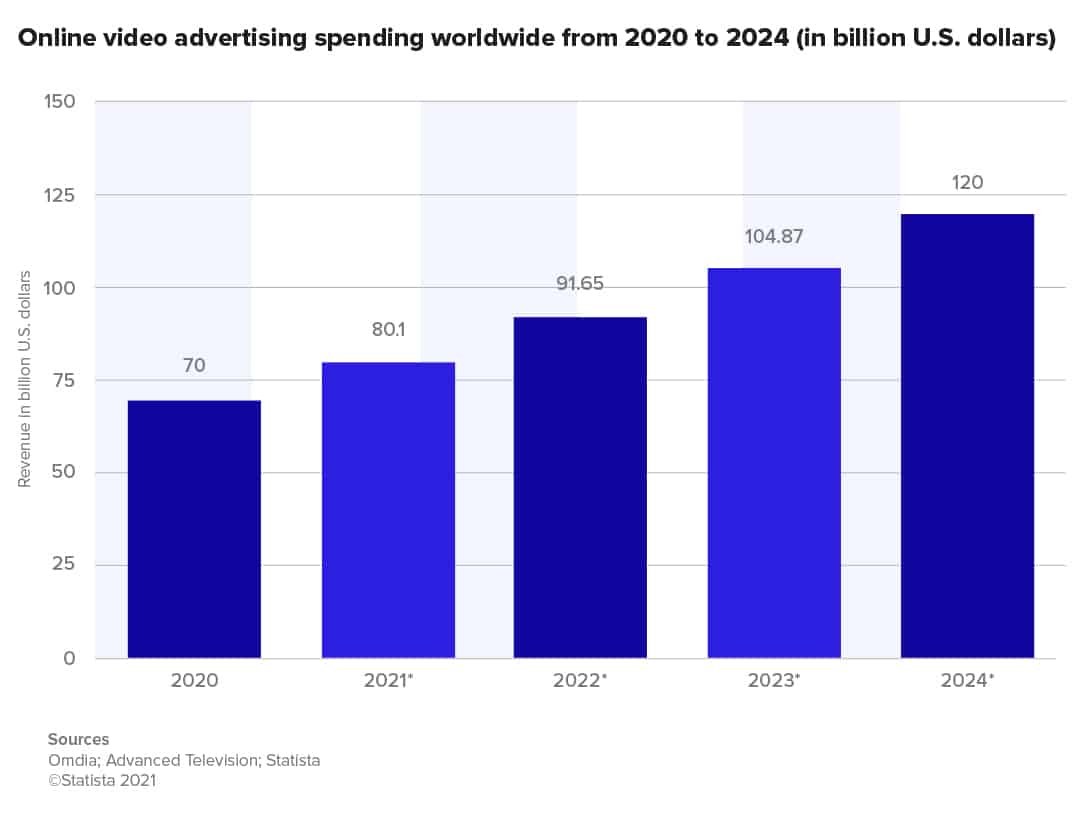
In 2020, online video advertising spending totaled $70B worldwide – by 2024, it’s projected to total $120B, or an increase of more than 70%. The reason is simple: advertisers go where consumers are, and consumers are flocking to social media sites, websites, mobile games, podcasts, and online stores like never before – all places where video content is king.
With the prevalence of digital media and e-commerce only projected to grow, it’s no wonder that your digital advertising dollar may not go as far tomorrow as it did yesterday (or today).
So, with these trends being what they are, ClickBank wanted to hear from real businesses that depend on e-commerce for their livelihoods and share their responses. In the next section, we reveal the results of this enlightening survey.
Key Findings From ClickBank's Highest-Earning Clients
ClickBank has the distinction of working closely with hundreds of successful businesses from around the world. These are companies making six, seven, or even eight figures per year across a wide range of industries and verticals.
So, in addition to the broad trend data we sourced for this report, we polled more than 100 of our own 7-figure clients to share their key takeaways for 2022.
Here are the topics we asked them about, and what they had to say in response.
1) How many marketing channels generated revenue for your business in 2021?
We asked businesses how many marketing channels they were able to generate revenue from in 2021. Here’s how their responses broke down.
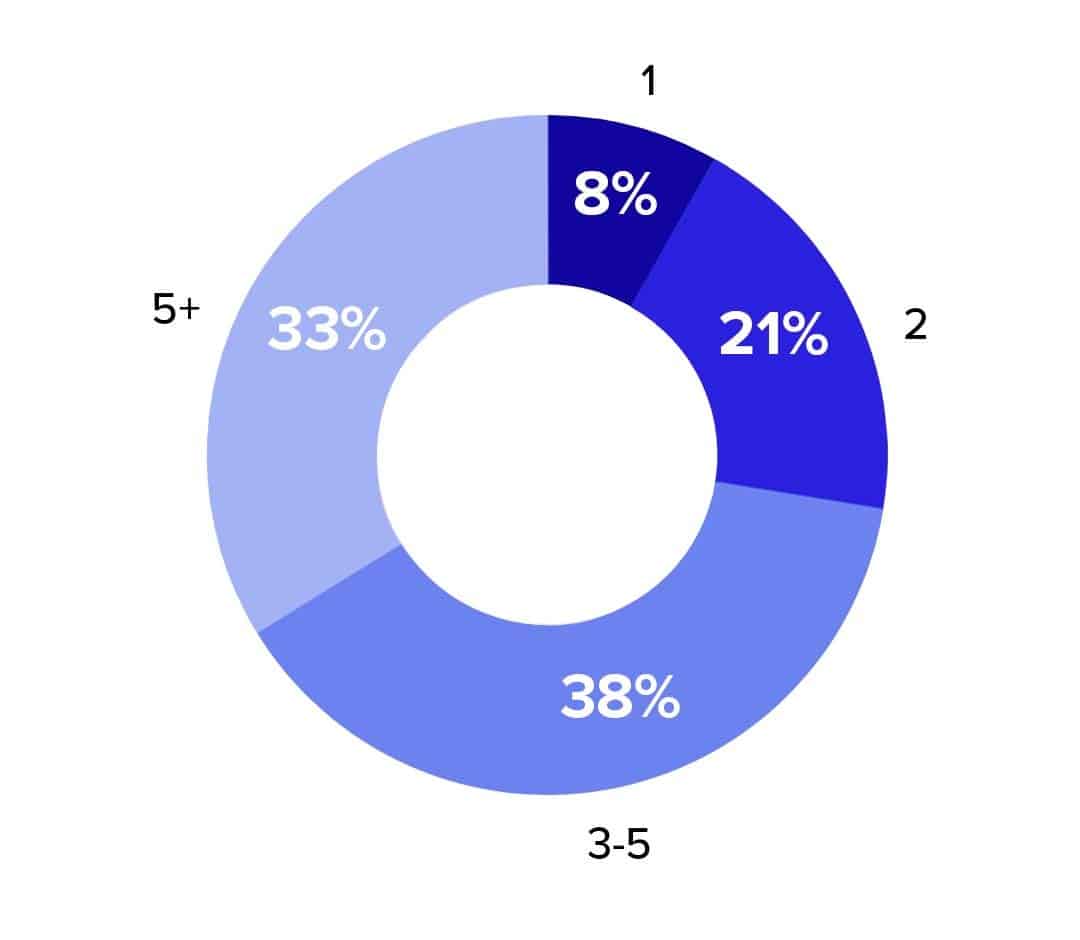
As you can see, the vast majority relied on 3 or more channels, and only the slimmest minority (8%) stuck with just 1 channel. As we emphasize throughout this report, channel diversification is a huge initiative for businesses in 2022.
2) Which channel will be your biggest focus in 2022?
When we asked businesses which marketing channel they’re most focused on in 2022, we got a pretty wide range of responses.
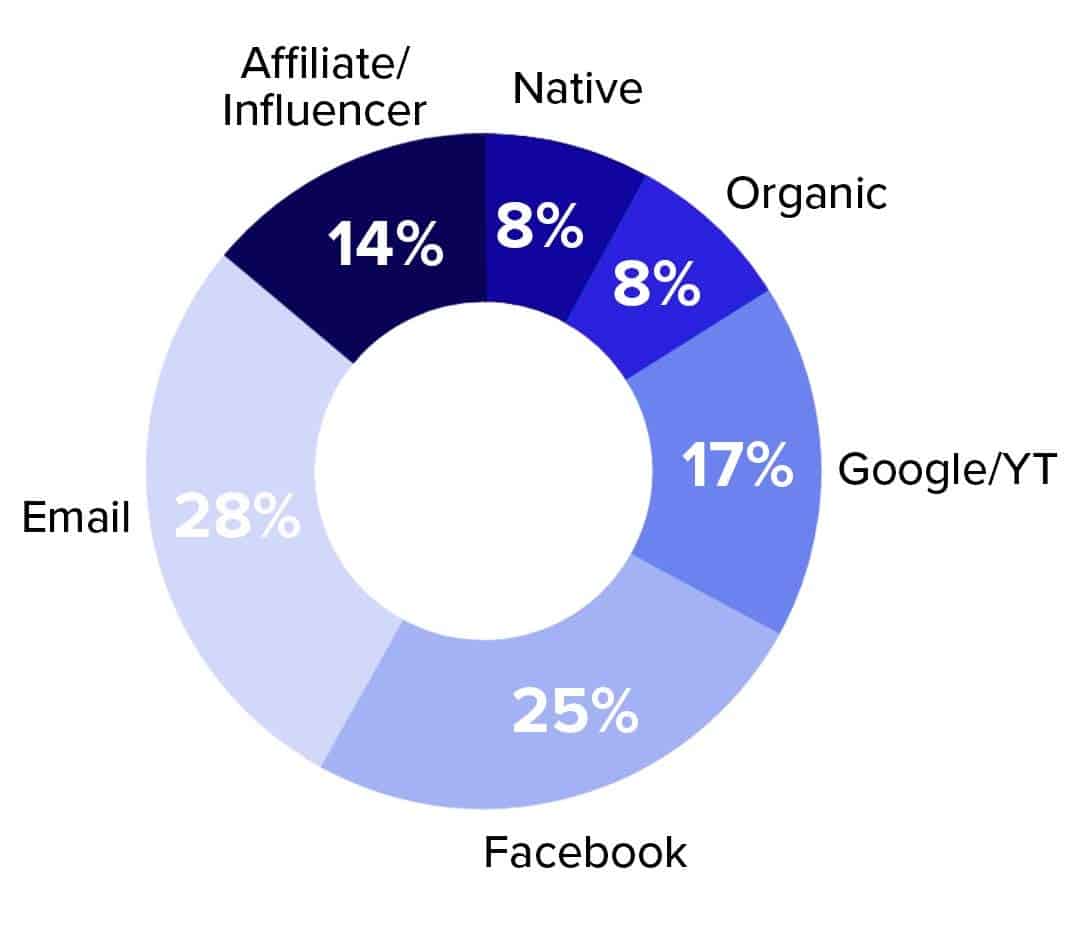
A slightly higher margin of respondents favored email as a focus, but Facebook and Google/YouTube were also strong contenders. This finding suggests that there isn’t a single dominant marketing channel in 2022.
3) What’s the biggest investment you’ll be making in 2022?
There’s a perfect storm of rising demand for paid ads and rising media costs. That’s why we’re seeing such a huge spike in projected ad spend for 2022.
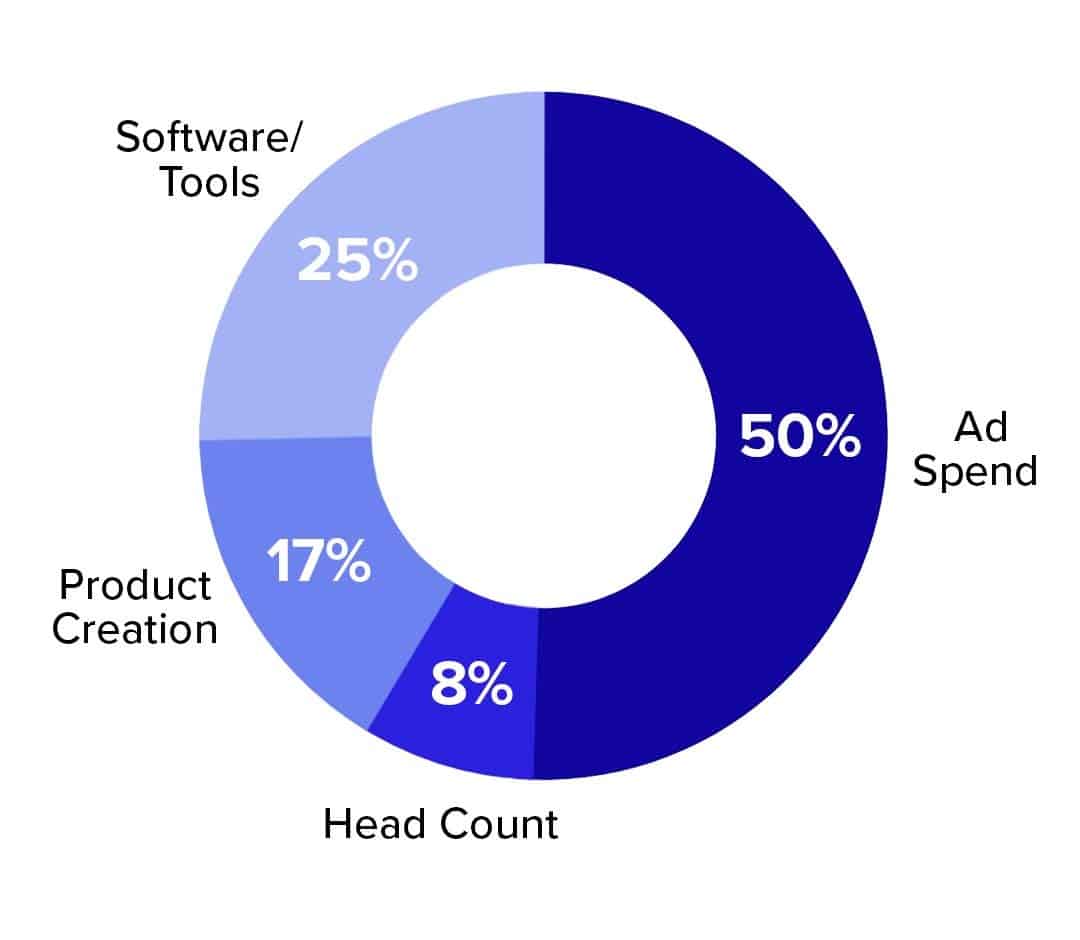
It’s not necessarily a surprise, but it’s still fascinating to see how much of their budget these seven-figure businesses plan to invest in ad spend – especially when compared to other key categories like software, product, and workers.
4) What is the biggest challenge you face as your business continues to scale?
If you break out the old SWOT analysis from your old business classes, there are several weaknesses and threats that business owners are concerned about in 2022.
Here are the top 5.
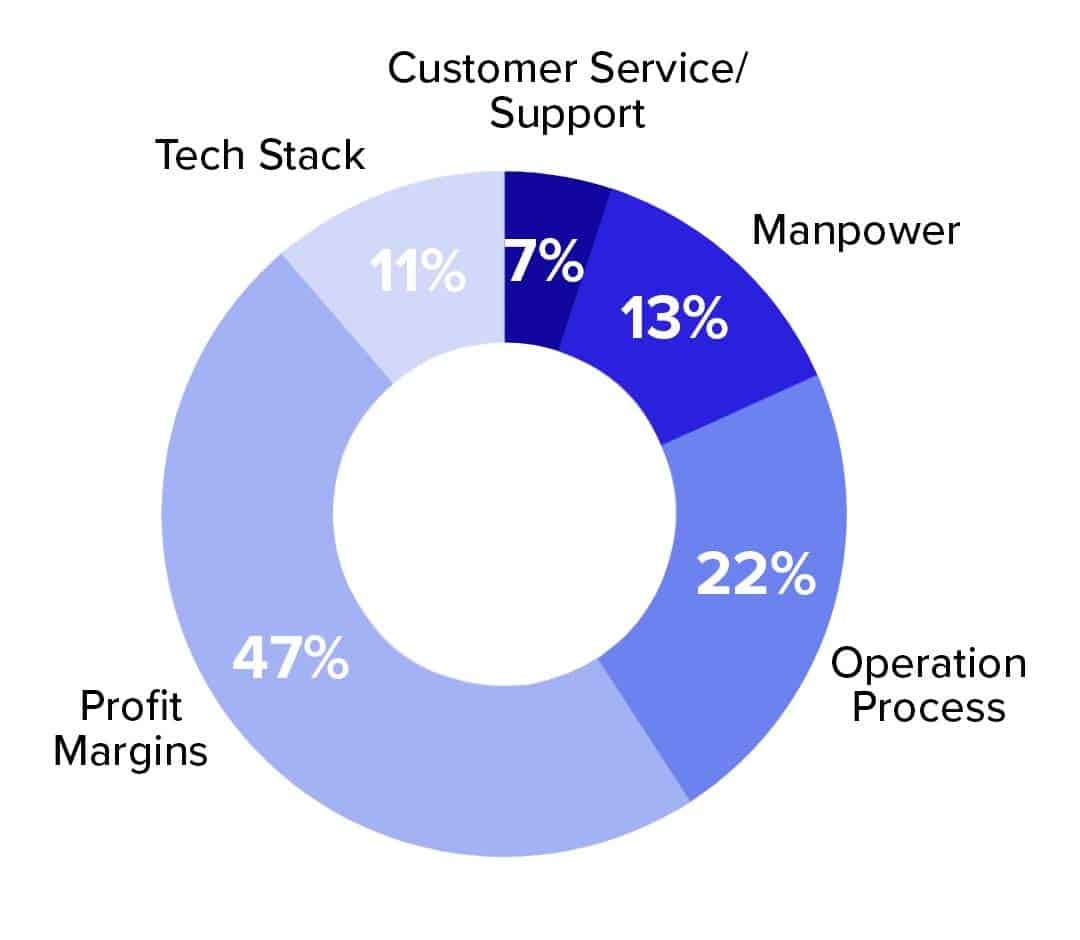
More than anything, profit margins are keeping business owners up at night.
5) What’s the biggest trend you’re most excited about in 2022?
We received some great nuggets of wisdom from businesses about the trends they’re looking forward to in 2022.
Here are a few quotes directly from these top business owners on anticipated 2022 trends:
- Using AI for copywriting, video creation, and scripting.
- Leveraging new tracking software to scale further.
- Automation possibilities that didn’t exist a couple of years back. And by automation, I am not just referring to the rules that you set within the traffic sources, but also the overall daily routine tasks involved in running the business.
- Leveraging new social platforms for lead generation.
- Rising costs will only allow the persistent entrepreneurs to prevail in 2022 amid fierce competition.
Channel Trends for 2022: What the Experts Are Saying
We’ve heard from businesses in the e-com trenches, but now, let’s hear what channel experts had to say.
Thanks to ClickBank’s Affiliated podcast, we have the pleasure of speaking to renowned marketing experts in everything from Facebook Ads to SEO. In 2021, we were able to collect their expert predictions, insights, and actionable tips and compile them into the following channel overviews.
Read on to discover their 2022 predictions about the biggest e-commerce marketing channels, including Facebook, email, and affiliate!
Facebook Channel Overview
Facebook had a mixed year. While it’s still the biggest digital ads platform on the planet, it also had to deal with political oversight, tracking changes caused by Apple’s iOS 14 update, and a sudden rebrand to Meta.
But for e-commerce brands and entrepreneurs, the trend to pay attention to is increased ad costs. Facebook Ads were always pay-to-play, but the cost of entry is going higher. According to Curt Maly, social media expert and co-founder of Social Black Box, “A lot of people are going to be priced out of the market on Facebook over the next two years.”
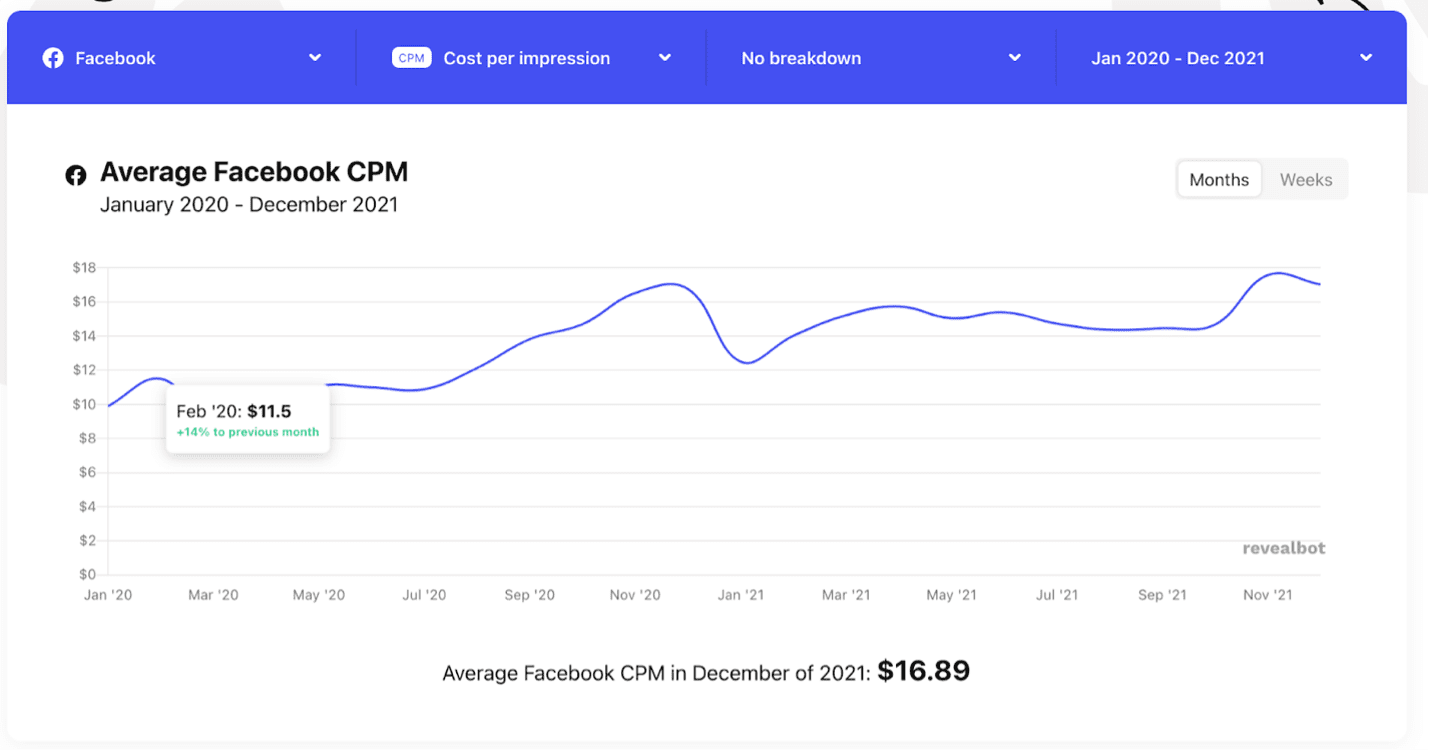
Here’s why.
1) Increased demand for ads. More businesses than ever are looking to capitalize on paid social ads, which is leading to rising costs. Like with any traditional marketing channel – from radio to TV – the costs of PPC rises as demand for ad space grows faster than the supply of users consuming ads, and as larger corporations continue to put more of their budget behind it.
2) Privacy changes. Apple’s iOS 14 privacy changes have led to a shift from direct attribution to aggregated events. In other words, you can’t get as granular with your targeting or optimizing, which means you’ll have to make it up with scaling. You’ll also have to be okay with a lack of perfect attribution – there’s probably a 20% variance between your reporting tools and what Facebook says.
3) Funding the metaverse. Facebook is self-funding its “metaverse” through increasing advertising costs. They’re raising rates to get some people out, but they’re also raising their own money internally by cranking up their ad spend.
Bottom line? If you’re not providing a quality experience or helping users, then Facebook is absolutely going to have limited space for you on the platform.
So, if your business is reliant on Facebook for leads or sales, it’s time to think about diversifying. You should also brace for higher costs in the next few years.
In the meantime, here are a few action tips from Curt Maly to help you make the most of Facebook for your business.
Action Tips:
- If you’re only running conversion ads, you’re doing the same thing as everyone else. This is “hands down” the most expensive ad type you can run. Experiment with other ad types – for example, the CPM on a video view could be less than 1/5th the cost.
- Ad buying is going to get a lot more automated in the future, so dial in your marketing creative and focus on providing the best possible user experience.
- Use different objectives to see what the different costs are. Even just test $50. Second, look at your CTR on the ad. High clickthrough rate doesn’t automatically mean it’s a great ad. It means there is interest, but what about intent? Find your lower CPM, CTR on ad. Do you have at least over 1%?
Email Channel Overview
With the ubiquitous shift toward greater privacy extending to email, it’s no surprise that email has rapidly shifted to a more relationship-oriented medium. At the same time, the data you can collect via email is more important than ever.
According to Jimmy Kim, founder of email service provider Sendlane, digital marketers are a little behind the curve on email, because the need for change hasn’t been too important… yet. But the way you approach email will likely have to change in 2022 and beyond.
Here are the top trends that Jimmy Kim identified about email marketing.
1) Your emails live or die based on relationships. People want to be treated like humans these days, not just another number. The brands that are building value have seen the greatest years ever – everyone else is struggling with data problems, deliverability issues, and more. One of the best ways to cultivate that relationship is to use a unique, personal voice and tone in your customer email messages.
2) Information and data are key. There’s a wealth of data behind email that you can use to deliver more meaningful messaging and attract the people who want to hear your message. The e-commerce space (the physical world) has mastered this already, whereas the digital space is just starting to understand how important information and data are.
3) Lead attrition is increasing. Lead attrition is at an all-time high with batch and blast type email sends, especially when you factor in deliverability. But when you look at the companies that are really taking care of their customers, they’re generating more revenue than the average Joe AND their customers absolutely love them.
Bottom line? The keys to email going forward are relationship-building, quality content, and branding. Because there’s more competition and less customer attention to go around, you need to step up your game and deliver greater value than ever before to stand out.
Consider these tips from Jimmy Kim to take full advantage of the email marketing channel.
Action Tips:
- If your customers aren’t opening and clicking your emails, it doesn’t mean that you have to get rid of them right now. It just means you should start slowing that email frequency down and really target the customers who want your email, while sprinkling in re-engagement emails along the way. This means actively segmenting your lists and pruning unengaged subscribers.
- Deliverability is like a cup of water. Every time you send emails to customers who don’t open, you’re pouring water out of the cup. Every time your customers open, you’re pouring water back in. Eventually, your cup runs out – and when that happens, your open rates are down, your click rate is down, and you’re generating no revenue. That’s why you must make deliverability one of your key performance indicators.
- The email world has changed a lot in terms of deliverability. ESPs all have their own spam trap algorithms and for all of them, content is king! The more unique your content is, the better deliverability you’ll have. The best in the game consistently provide quality, relevant content to people who want to be in their list, while pruning the ones who don’t.
Affiliate Channel Overview
There’s a lot to say about the affiliate channel for e-commerce in 2022. In some ways, it might be your antidote to rising media costs, as you can spread those out among third-party affiliates and only pay for the sales they generate. The affiliate channel can help you mitigate your own marketing costs while continuing to acquire new customers.
According to Thomas McMahon, Senior Business Development Manager at ClickBank, “If affiliates aren’t driving 30% of your revenue, you’re already behind. Good affiliates are worth their weight in gold for you, and a lot of businesses want to work with them, so understanding them is key.”
Here are a few trends to recognize as you position your business for the affiliate channel in 2022.
1) Affiliates are getting “lazier.” We mean this in the nicest way possible, but top affiliates simply have too many quality offers to choose from to be bothered doing all of the content creation from scratch. Yes, you’re paying them on a performance basis, but if they’re good at what they do, someone else is providing all the resources they need to do their job. Besides, who knows your product better than you do?
2) Give them data and numbers. More than ever, top affiliates want to promote proven offers. This means you should be doing a lot of testing and optimizing before you even bring your offer to an affiliate to promote, through sources like paid ads and email sends. If you don’t have a house email list, you may need to pre-pay to get your offer sent to a legit list – but even if it doesn’t covert as well as you’d like, the data you collect is invaluable.
3) It’s truly who you know. You may have the best product out there, but in the affiliate marketing business, your best chance to recruit a top affiliate is a warm introduction from a mutual contact. This won’t happen overnight, but if you focus on building your network and establishing relationships, you can see dramatic moves overnight. All it takes is one “whale” affiliate to change the course of your business forever.
As we discussed in the section on email, managing relationships is your most important job in 2022 – and that includes both your customers and any affiliate partners you connect with.
But perhaps the defining trend for affiliate marketing in 2022 is the growing competition for attracting and working with top-tier affiliates. According to affiliate expert Amber Spears, the successful affiliates you’d love to work with are getting more than 300 unsolicited requests per day from strangers, on average.
The best affiliates have proven that they can sell products at scale – and just one or two of them can be a game-changer for your offer and your business. Take the following tips from Thomas McMahon and Kyle Kostechka to heart if you want to make the most of the affiliate channel for your business.
Action Tips:
- If you haven’t yet provided resources for your affiliates, such as email swipes, ad creative, tracking links, and demographic data, creating these resources is your top priority. Make it as easy as possible for affiliates to promote your offer.
- You can qualify the right affiliates on your affiliate tools page. By creating a dedicated page for affiliates, you have a place to field more inbound affiliate leads and work with them.
- Promoting other people’s offers can go a long way in getting them to promote yours. If your desired affiliate is also an offer owner, promote their offer with your audience first and record how it goes. This effort will show that you can do well with their offer, which makes the conversation easier when you reach out to see if they’ll promote your product as well.
Other Channel Trends
While Facebook, email, and affiliate are the top channels we see our clients working with, there are a handful of other important traffic channels for e-commerce.
We’ve seen many of our top clients start experimenting with native ads as an alternative to Facebook or YouTube. There’s also renewed interest in organic/SEO as a channel – one that’s less susceptibility to the volatility seen in some of the dominant channels in 2020.
We also want to point out the growth of video as a content format worldwide. Across all online video segments – including transactional video on demand (TVoD), subscription video on demand (SVoD), and ad supported video on demand (AVoD) – we’re seeing a tremendous boost in users, engagement, and total revenue.
In fact, the total number of video on demand users across the globe is projected to grow from approx. 1.75 billion users in 2021 to 2.25 billion users in 2025.
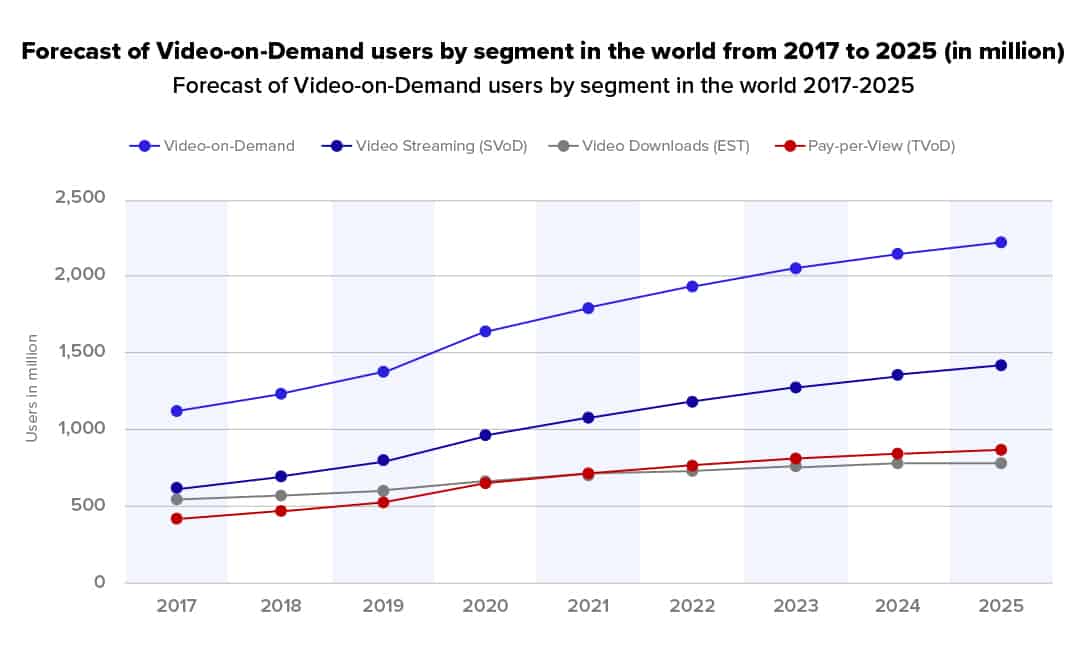
Whether you’re creating short-form video content for TikTok, long form videos for YouTube, or something in between for social sites like Instagram and LinkedIn, the prevalence of video is only going to grow across channels for the foreseeable future.
Traffic Trend Summary
Clearly, businesses and e-commerce brands are still getting traction with big channels like Facebook, email, affiliate, and more.
At the same time, traditional marketing channels like YouTube and Facebook Ads have matured to the point of saturation, thanks to a flood of spend from well-established corporate advertisers and brands.
That’s why we recommend taking a look at growing organic channels – such as TikTok or Twitch – on the organic side, and at up-and-coming paid media platforms where you can see great results again, such as Spotify’s podcast ads platform.
It’s too early to tell for sure where the best opportunities will be, but diversifying your marketing channels is the name of the game in 2022. It’s inevitable that e-commerce businesses are going to continue to market more online, so your best strategy to fight back against overwhelming competition is to go where your competitors aren’t – plain and simple.
2022 Traffic Trends Report Conclusion
We’ve discussed several upcoming e-commerce trends in this report, but in terms of the biggest takeaways, here are the top 4 things to expect in 2022:
- Continued growth in total shoppers and brands transacting online.
- A shift toward greater privacy and relationship-oriented marketing.
- Rising demand and costs for social ads.
- Greater need for diversification in e-commerce channels.
With such significant changes coming in 2022, one of your best opportunities is leveraging affiliate marketing.
Through affiliate marketing, you’re inviting expert marketers to reach out to potential buyers wherever they are online on your behalf: Facebook, YouTube, publisher sites, email, social, and more.
Let them do what they do best – marketing your product to their audience – while you focus on building a better product and customer experience.
Of course, instead of needing to grow an affiliate program from scratch, you can tap into the existing affiliate network on ClickBank. If you haven’t already created a free account, we invite you to see if ClickBank is a good fit for you in 2022.
Sign up for a free account here.
And for more data trends, industry insights, and deep conversations about affiliate marketing and e-commerce like this report, check out ClickBank’s popular Affiliated podcast.

